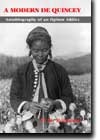| Our Publications | ||
| Books by Title | ||
| Books by Author | ||
| Books by Country | ||
| E-books | ||
| About | ||
| Orchid Press E-books | ||
| Distributed E-books | ||
| Our Bookshop | ||
| About Us | ||
| Browse Shop | ||
| How to Buy | ||
| Contact Us | ||
| WE BUY BOOKS AND LIBRARIES | ||
|
||
Book Reviews

A Modern de Quincey:
Autobiography of an Opium Addict
byH. R. Robinson
2nd edition 2004. 152 pp., 5 b & w plates, 1 map, 215 x 152, Softcover
ISBN-10: 974-524-038-9 $23.00
ISBN-13: 978-974-524-038-4
Downhill To Mandalay
Book review by Emma Larkin,
(The South China Morning Post, Sunday, 11 July 2004)
With chapters called “Opium”, “The Five Virgins” and “The Abyss”, Herbert Reginald Robinson’s autobiography is clearly not your average colonial memoir. A Modern de Quincey, a reprint of an obscure book first published in London in 1942, chronicles one Englishman’s demise in the opium dens of Mandalay in Burma. Robinson’s irreverent disregard for moral niceties and never ending drug binges make this book an intriguing and exotic colonial precursor to Hunter S. Thompson’s Fear and Loathing in Las Vegas.
The narrative skims over Robinson’s childhood and early years in the Indian army. It begins in earnest when he is posted to the wild mountains in the northernmost provinces of Burma in 1921. After a couple of years he leaves the army and heads for Mandalay. There, he has his first taste of opium administered to him by the enigmatic Ba Ohn, who wears a multi-coloured silk sarong and has flashing eyes and scarlet lips set against porcelain-white skin.
Robinson soon becomes a regular client of Ba Ohn and goes each evening to The House of the Deer, an opium den secreted down a dark alley in Mandalay.
Robinson’s nights are taken over by vivid opium dreams, in one of which he is elated to discover the key to the universe, “the final answer to the eternal why?”. But in the cold morning light of sobriety, the answer Robinson found must have lost some of its poignancy “The banana is great but the skin is greater.”
The opium addiction soon overpowers Robinson and his attempts to break free-including a stint as a Burmese monk-fail. Smoking all day, his body begins to waste and he slides into debt. When the authorities knock on his door with a warrant for his arrest over unpaid bills, he points a Browning automatic at his head and pulls the trigger. He survives, though his eyeballs are blown out of his skull.
A new foreword by Gerry Abbott—a teacher and writer who specialises in Burma—points out the compelling links between Robinson and another British author, George Orwell. While Orwell was training for his job in the Imperial Police Force, he lived in Mandalay around the same time as Robinson. The two were clearly acquainted. Many years later Orwell reviewed A Modern de Quincey. Orwell’s critique has also been reprinted in this edition. The author of 1984 describes his pleasure at learning that Robinson was still alive and well. Abbott proffers the theory that Robinson’s attempted suicide may have echoed through Orwell’s imagination in his novel Burmese Days, which ends with the main character, John Flory, putting a gun to his head and killing himself.
To add to such tantalising speculations, it might be interesting to note Orwell’s own link with opium. During colonial times, opium was grown and sold under a government monopoly in which the British profited off drug addicts in the east. Orwell was personally connected to this exploitation since his father worked as an opium agent for the British empire in India. Meeting Robinson in Mandalay must have provided the young Orwell with a firsthand account of the ravages of opium—a direct, though no doubt unwitting, result of the work done by his father. The experience may well have added to the rabid anti-imperialism Orwell displays in Burmese Days.
As for Robinson, he returned to England and after studying at the Massage School of the National Institute for the Blind he went on to work as a hospital physiotherapist in South London until his retirement in the 1960s. In March 1965, exactly 40 years after his first attempt, he succeeded in killing himself.
[Read a review from The Fortean Times] [Read a review from The Nation] [Read a review from The Guardian] [More Orchid Press Reviews]
PO Box 70, Trinity TB, NL, A0C 2S0, Canada
Telephone: +1 709-330-4703